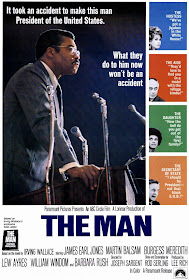An awful picture that only
comes alive when it succumbs to lurid extremes, Thumb Tripping is a road movie in which neither the travelers nor
the journey is interesting. Michael Burns plays Gary, a
sweet-natured college kid who drops out of mainstream society for a summer of
hitchhiking in Northern California and thereabouts. He soon hooks up with Shay
(Meg Foster), a spaced-out hippie chick, but for the first 20-ish minutes of
the movie, nothing happens. Gary and Shay mill around small towns including
Carmel, occasionally getting hassled by the man, and they camp in a seaside
cave with other hippies. (There’s literally a five-minute scene in the cave during
which the four characters discuss the virtues of soup as a dietary staple.) Then
the movie shifts to a series of episodes revolving around the weird people who
give Gary and Shay rides. The best sequence features Bruce Dern as Smitty, a
quasi-psychopath who threatens the kids with a knife; although Dern is typecast
as a violent nutter, he’s so vital he almost makes the movie
seem purposeful. Almost. Michael Conrad, later of Hill Street Blues fame, plays a horny
trucker eager to get into Shay’s pants, and the final major characters are Jack
(Burke Byrnes) and Lynn (Marianna Hill), hard-partying drunks who lead the
heroes through high junks such as bar-hopping and skinny-dipping. Thumb Tripping is beyond pointless, not
only because the story never goes anywhere, but also because the lead
characters are twits. Gary’s an inactive cipher who simply
watches things happen, except when he’s demonstrating squaresville hang-ups,
and Shay is such a reckless wastoid that it’s bizarre we never see her drop acid. As for the acting, Burns is fine in a nothing role, Foster’s icy-blue
eyes are as striking as ever, Conrad is effectively sleazy, and Byrnes and Hill
are awful—hyper and screechy from their first frames to their last. Worst of
all, the movie lacks a point of view: It’s neither a celebration of the
counterculture lifestyle nor a condemnation, and since Gary’s just a visitor in
this world, it’s not a docudrama, either.
Thumb Tripping: LAME

















